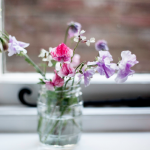How to Create Good Feng Shui in Your Apartment
“Feng shui” literally translates to “wind and water.” Cultures across the world traditionally associate these elements with health, luck, and well being. Feng shui is a set of practices intended to improve the flow of energy and create harmony within the home. Although feng shui originated in ancient China, its philosophy and practice are still alive to this day.
Many apartments are small spaces with layouts that suit the building they’re in, rather than your preferred living style. Depending on the lease agreement, apartment living can come with its own set of restrictions; you might not be able to repaint, change the fixtures, or otherwise make the space feel like it belongs to you. Feng shui principles let you change the atmosphere of your apartment without making changes to the physical space. Whether you live in a studio or a penthouse, feng shui can help you create an environment that makes you feel truly at home.
What is Feng Shui?
Practitioners of feng shui refer to it as an art and science. Feng shui is an energy practice. It states that you, as an individual, have your own energy, as does everyone and everything around you. As people and object interact, these energy fields cross and affect one another. Everything you see or touch becomes a part of you and your life experience.
Your home and your possessions are at the center of your life. According to the principles of feng shui, the state of your home can dramatically affect your energy. If your house is poorly organized, you will find yourself in disarray and confusion. If your home is well put together, you will be able to find calm, joy, and success in your life.
Whether or not you believe in the energies behind feng shui, its hard to argue that the state of your home doesn’t impact your attitude. Centuries of ancient wisdom have come together in feng shui to provide a guide to flow, aesthetics, and harmonious living. As you explore the principles of this art form, pay careful attention to your intuition. Your own energy and instinct will lead you to harmony far better than any chart or set of rules.
The Basic Principles of Feng Shui
Feng shui is a complicated science, but it starts with two basic principles: the yin and yang, and the five elements.
The concept of yin and yang is that of balance. The yin yang symbol is half white and half black. These two halves represent light and dark, day and night, logic and emotion, love and hate. The importance is not in which side is white and which is black, but rather in that both sides are perfectly equal and balanced against one another. Just so does feng shui recommend that you find balance in all aspects of your home and your life.
The five elements of feng shui are fire, earth, wood, metal, and water. Each of these elements has its own associations, both within Chinese culture and within other cultures across the world. In a feng shui design, the elements are represented by associated colors or objects.
- Fire is red or orange and represents passion.
- Earth is yellow or brown and represents structure.
- Wood is green or teal and represents growth.
- Metal is white or grey and represents stability.
- Water is blue or black and represents adaptability.
The Feng Shui Bagua
A bagua is a feng shui energy map. The most commonly used is the Classical bagua, which divides your home into eight sections based on compass directions.
- South is of fame and reputation.
- Southwest is of love and relationships.
- West is of creativity and legacy.
- Northwest is of people and travel.
- North is of work and career.
- Northeast is of knowledge and spiritual growth.
- East is of health and family.
- Southeast is of money and prosperity.
The Western bagua takes this chart but makes one small change: instead of using cardinal directions, the areas are determined by the location of your front door. According to the Western bagua, the wall you face when you stand in your front doorway is “south” for feng shui purposes.
As you decorate, you can choose to use the Classical bagua directions, apply the Western orientation, or go with a combination of the two. The important thing is how the results make you feel about your home.
Start with Your Front Door
Your front door is the first thing you see when you return home, and should be the place where your feng shui efforts start. Take a moment to stand outside and look at your entrance. Is your door clean and well maintained, or is your threshold dirty? Does your door squeak when you open it? These small details can make a large difference in the way you feel about your home. Before you move on, give your front door any cleaning or repairs you think it needs.
After you open your door, the next thing you see is the entryway. This differs for every apartment. You may have a small hallway, or the door may open straight into a wide studio room. Make sure your entrance is clean and free of clutter. You may consider placing an air freshener or hanging a painting to ensure that your first impression of your home is a beautiful one.
Remove Clutter and Encourage Openness
Everything you interact with is a part of you, so don’t interact with items you don’t like. Feng shui involves a heavy amount of minimalism; if you don’t like or need it, you shouldn’t keep it in your home. Go through your apartment and clean or remove clutter. If anything brings you consistent stress, like an extremely messy desk, you should make that one of your first cleaning priorities.
Once your clutter is gone, take a moment to consider your furniture layout. Feng shui principles ask for an open layout that allows energy to flow freely. As an example, a bookcase blocking your view of the kitchen might make things feel cramped and halt conversation. Place your items in a way that feels open, airy, and pleasing to the eye. Everything should be easy to access and use for its intended purpose, and walking from one point to another should feel natural and relaxed.
Decorate According to the Bagua
Now that your apartment is clean, open, and ready to flow with energy, it’s time to apply your feng shui knowledge. Print out a bagua chart or pull one up on your phone and determine which parts of your apartment best suit each area. Remember that baguas apply to individual rooms as well as to the apartment as a whole; your bedroom might be within the south area, but can also have its own areas inside of it.
Your decorations should reflect both the area they are in and the aspects you would like to bring to it. If you want growth in your career, try applying wood decorations to the career area. If you want stability, apply metal decorations. Some decorations have very specific associations; mirrors are thought to bounce energy, and shouldn’t be placed anywhere that causes stress.
Along the way, use your intuition to make sure that no items conflict with one another. Remember to keep things open, flowing, and free from clutter. A relaxed and joyful environment is more important than specific associations. The success of the bagua relies on how you interact with each of the individual elements. Your ideas of love or money may be very different from someone else’s, and you should choose decorations that resonate with you.
Feng shui can become complicated very quickly. Different sources have vastly different recommendations on where to place items, how to light each room, and what associations each color really has. In the beginning, focus on layouts that are clean and comfortable, express your personal interests, and make you feel happy in your home. If you approach every aspect of decoration with a balanced and loving attitude, your home will quickly flow with positive and joyous energy.






